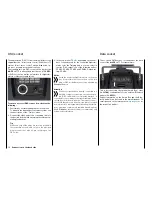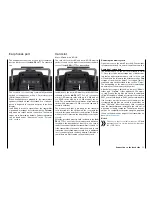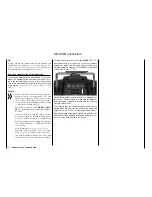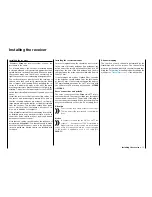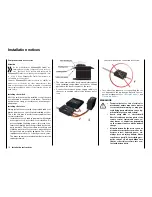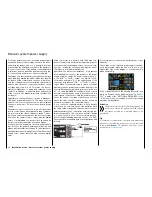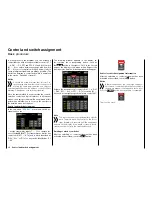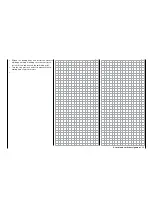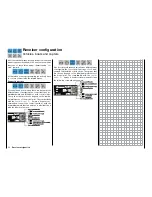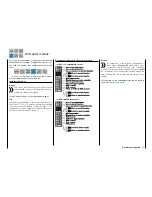
The 1s lithium-ion battery in the set comes with a
special safety shut off. The voltage differences be-
tween individual cells are therefore not balanced
by means of the usual balancer plug-in connec-
tion.
• If the battery heats up above 60°C while it is be-
ing charged, stop charging and let the battery cool
down to approximately 30°C.
• The batteries may not be modified. Do not directly
solder or weld the cells.
• To avoid deformation, avoid excessive mechanical
pressure.
• Make sure to observe the charging and discharg-
ing instructions.
Storage
LiIo/LiPo cells should be stocked with about 50% of
their nominal capacity. If the cell voltage falls below 3
V during the stocking, the lithium ion/lithium polymer
cells must be recharged to 50% of the full capacity.
Otherwise, the battery will die during storage and be-
come useless.
Special instructions on discharging
Graupner
LiIo/LiPo polymer batteries:
• A continuous current of approximately 1 C does
not pose a problem for
Graupner
lithium-ion/lithi-
um polymer batteries. If the current is higher, refer
to the instructions in the catalogue. Bear in mind
the maximum load for the plug-in system (see the
maximum discharge current indicated on the bat-
tery label).
• Discharging below 2.5 V per cell will damage the
cells and should therefore be avoided at all costs.
• The batteries should never be short-circuited.
Short-circuits generate a very high current which
heats up the cells. This causes a loss of electro-
lyte, gas formation or even explosions.
Graupner
LiIo/LiPo batteries should therefore be kept away
from and not touch conductive surfaces due to the
short-circuit hazard.
• The battery's temperature during discharging
should never 70°C. If this occurs, make
sure that the battery is sufficiently cooled, or re-
duce the discharge current. The temperature can
be easily checked using the infrared thermometer
(No.
1963)
. However, the battery may not be dis-
charged using the transmitter's charging socket.
This socket is not designed for this purpose.
Additional instructions on handling
• The battery capacity decreases each time it is
charged and discharged. Charging when the tem-
perature is too high or too low can also gradually
reduce the battery's capacity. After 50 cycles, the
battery capacity of models is only 50-80% of that
of a new battery due to the occasionally high dis-
charge current and induction current of the motor,
even when all charging and discharging instruc-
tions have been followed.
• Batteries may only be series-connected or paral-
lel-connected in exceptions since the cell capacity
and charge can differ. The battery packs that we
supply are therefore preferable.
• The connections of lithium ion/lithium polymer
batteries are not as robust as other batteries. This
holds true particularly for the plus pole connection.
The connections can easily break.
Cells connection
Attention
Direct soldering on the battery cells is impermis-
sible. The heat from direct soldering can damage
battery components such as the separator or
isolator.
Battery connections should only be created by spot
welding in the factory. If the cable is missing or sev-
ered, have it repaired professionally by the manufac-
turer or dealer.
Replacing individual battery cells
Attention
Individually battery cells may only be exchanged
by the manufacturer or dealer and not by the
user.
Do not use damaged cells
Damaged cells may not be used.
Indications of damaged cells include damaged hous-
ing packaging, deformed cells, the smell of electrolyte
or leaking electrolyte. The battery may not be used in
these cases.
Damaged or useless cells are considered hazardous
waste and must be disposed of properly.
Contact with liquids
Batteries may not be immersed in liquid such as tap
water, sea water or beverages. Avoid all contact with
liquids of any kind.
23
Safety and handling instructions for lithium-ion/lithium polymer batteries
Summary of Contents for mz-24 PRO
Page 13: ...13 Personal notes...
Page 19: ...19 Personal notes...
Page 37: ...37 Personal notes...
Page 59: ...Touch 59 Base menu Model selection...
Page 79: ...79 Personal notes...
Page 89: ...89 Personal notes...
Page 115: ...115 Personal notes...
Page 153: ...Helicopter model function menus Common function menus 153 Personal notes...
Page 169: ...169 Personal notes...
Page 187: ...187 Personal notes...
Page 199: ...199 Personal notes...
Page 207: ...Fixed wing model function menus System menus 207 Personal notes...
Page 211: ...211 Personal notes...
Page 219: ...219 Personal notes...
Page 237: ...237 Personal notes...
Page 238: ...238 Personal notes...
Page 239: ...239 Personal notes...


